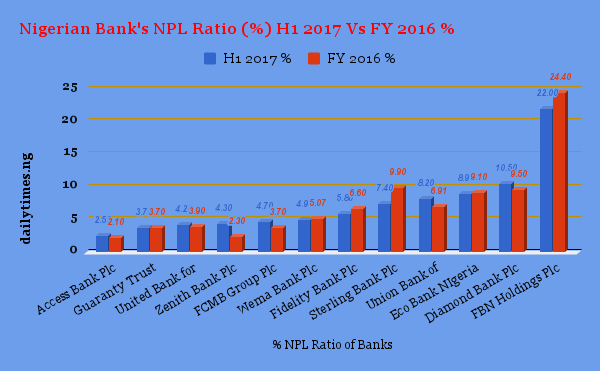Nigeria’s commercial banks’ ability to provide capital and stimulate investment for economic growth may be threatened, as the harsh economic conditions in the country may have forced the lenders to continue to violate Central Bank of Nigeria’s (CBN’s) regulatory five per cent ratio threshold on Non-Performing Loans (NPL).
This means than banks are not allowed to have an NPL ratio higher than five per cent. An NPL is the sum of borrowed money of which a debtor has not been able to meet up in scheduled payments for at least 90 days; and is either in default or close to being in default.
Once a loan is non-performing, the odds that it will be repaid in full are considered to be substantially lower, while the NPL ratio is the amount of NPLs over total loans, usually expressed as a percentage.
While the growing NPL of financial institutions across the country remains a source of worry amongst investors, DAILY TIMES investigation indicated that customer’s inability to repay obligations within the stipulated period stems from the stringent monetary policies, which include high-interest rate currently at practice in the country.
For now, an analysis of the NPL ratio of 12 Nigerian banks show that 6 of these banks maintained an NPL ratio within the stipulated regulatory requirement for the half year period ended 30th June, 2017, but findings by our correspondent reveal that some banks’ NPL ratio threateningly increase to hit unsafe parameters if caution is not exerted. For instance, Access Bank with the lowest NPL ratio of 2.50 per cent amongst the 12 banks covered, recorded a 0.4 percentage points increase in NPL ratio that sat at 2.1 per cent as at December 2016.
It is instructive to note that although increasing NPL’s and it’s ratio is a warning signal, a performing loan, however, will provide a bank with the interest income it needs to make a profit and extend new loans for greater development and provide faster stimulants for economic recovery.
The Nigerian Bureau of Statistics(NBS) had reported that Nigeria recently exited a five quarter long recessive state, a state that was primarily responsible for the asset battery suffered by the banks- the nation’s engine room for growth and sectoral development.
However, financial activities meant to speed up economic relief would remain a mirage if growing NPL’s are not dealt with. Some of the banks already dealing with the size of their NPL include Fidelity Bank, which recorded a 5.80 per cent NPL ratio in HY’2017, still above the 5 per cent regulatory cap, but significantly lower than 6.60 per cent obtained in FY 2016.
Sterling bank also reduced its NPL ratio in six months to 7.40 per cent as against 9.90 per cent obtained in December 2016. A commendable feat by the management of Wema Bank was the ability of the bank to maintain its NPL ratio below the CBN’s 5 per cent cap.
Wema’s NPL ratio as at June 2017 stood at 4.91 per cent compared to 5.07 per cent in the preceding six month period. FBN Holdings also trimmed its NPL ratio to 22 per cent in June 2017 as against 24.40 per cent in December 2016.
For EcoBank Nigeria PLC its NPL ratio, which sat at 9.10 per cent as at December 2016, had been prudently managed to 8.90 per cent as at June 2017.
Meanwhile, NPL’s management for other banks has not been as positive as quite a number were adversely affected by the erstwhile telecoms’ company, Etisalat, now known as 9 mobile.
Zenith Bank, which carries a total of US$262 million (N80 billion) of the Syndicated US$1.2bn Etisalat Loan, has the highest exposure of 3.5 per cent in relation to its loan book.
The bank has since made provisions, but consequently carries an NPL ratio of 4.30 per cent, still below regulatory limit, but a 2 percentage basis points increment from an NPL ratio of 2.30 per cent obtained in December 2016. Guaranty Trust Bank was also heavily exposed to the Etisalat loan with, US$137m or N42bn at risk.
However, the bank maintained a stable NPL ratio of 3.70 per cent, the same figure obtained in December, 2017. The NPL’s ratio at 10.50 per cent, for Diamond Bank is quite on the high side when compared to 9.50 per cent obtained in the preceding six months’ period and the 5 per cent prudential requirement stipulated by the Central Bank of Nigeria (CBN) for Deposit Money Banks.
Also, Union Bank recorded an NPL ratio of 8.20 percent compared with 6.91 per cent obtained in December 2016. UBA on its part was able to stay within the 5 per cent cap, but its NPL ratio increased from 3.90 per cent in December 2016 to 4.20 per cent as at June 2017.
For FCMB, a one percentage point increase was recorded in NPL ratio that sat at 4.70 per cent against 3.70 per cent recorded at the 2016 year end.
The fact that banks must set aside more capital on the assumption that the defaulting loans will not be paid back, diminishes investors’ worth and reduces the bank’s capacity to provide new loans.
To be successful in the long run, market experts opined that banks need to keep the level of bad loans at a minimum; so, they can still earn a profit from extending new loans to customers.
Analyst said, “If a bank has too many bad loans on its balance sheet, its profitability will suffer because, it will no longer earn enough money from its credit business.
In addition, it will need to put money aside as a safety net in case it needs to write off the full amount of the loan at some point in time.”




